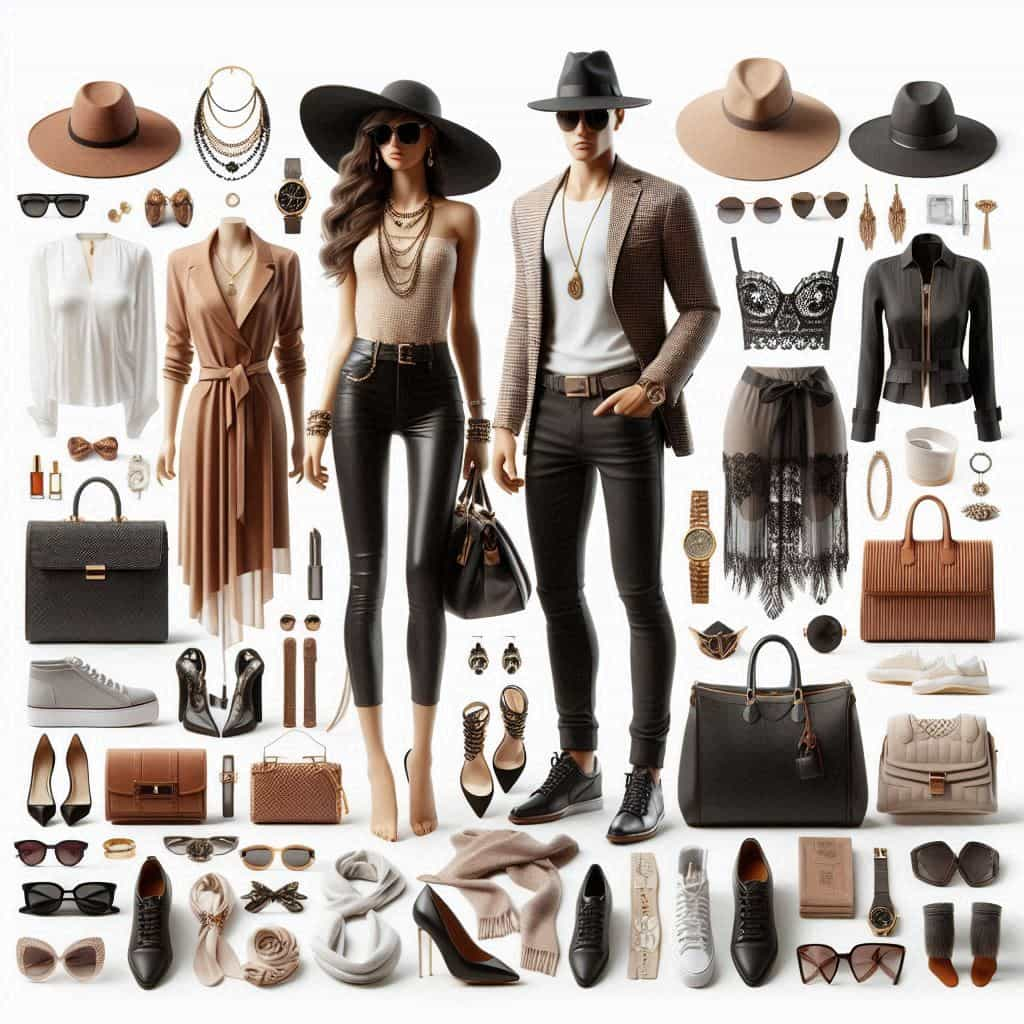
Creating a timeless wardrobe is all about building a collection of versatile, high-quality pieces that can be mixed and matched effortlessly. Whether you’re looking to streamline your daily outfits, or you need some quick tips for busy mornings, this guide will help you build a wardrobe that stands the test of time and suits every occasion.
Quick Outfit Tips for Busy Mornings
1. Plan Your Outfits the Night Before
To save time in the morning, plan your outfits ahead of time.
- Lay Out Your Clothes: Pick out your clothes for the next day and hang them up or lay them out where you can see them.
- Check the Weather: Make sure your chosen outfit suits the forecast. This way, you avoid last-minute adjustments.
2. Stick to Wardrobe Essentials
Keep your outfit simple and classic with these essentials:
- Neutral Basics: Opt for items like white shirts, black trousers, and neutral sweaters that go with anything.
- Comfortable Shoes: Choose shoes that are both stylish and practical, like loafers or sleek sneakers.
How to Build a Capsule Wardrobe for Men
1. Select Versatile Pieces
A capsule wardrobe consists of a few versatile pieces that can be mixed and matched.
- Basic T-Shirts and Shirts: Choose well-fitting, neutral-colored t-shirts and dress shirts.
- Tailored Pants and Jeans: Opt for classic, well-fitting pants and jeans that can be dressed up or down.
- Blazers and Jackets: Invest in a good blazer and a versatile jacket for layering.
2. Focus on Quality Over Quantity
Invest in high-quality items that will last longer.
- Durable Fabrics: Choose items made from materials like cotton, wool, and denim that withstand frequent wear.
- Timeless Styles: Stick to classic cuts and colors that won’t go out of style.
The Importance of Wardrobe Categories in Fashion
1. Organize by Type
Categorizing your wardrobe helps you find what you need quickly.
- Separate Sections: Divide your wardrobe into categories such as shirts, pants, jackets, and accessories.
- Use Dividers: Utilize closet dividers or storage bins to keep categories distinct.
2. Seasonal Rotation
Keep your wardrobe organized by rotating items based on the season.
- Store Out-of-Season Clothes: Place winter clothes in bins during summer and vice versa to keep your closet uncluttered.
- Easy Access: Keep current season items at the forefront for easy access.
How to Create a Daily Wear Rotation
1. Establish a Routine
A daily wear rotation ensures you always have something ready to go.
- Weekly Outfit Planning: Set aside time each week to plan outfits for the upcoming days.
- Create Outfits in Advance: Assemble outfits in advance and hang them together to simplify your morning routine.
2. Mix and Match
Combine items in various ways to keep your daily outfits fresh.
- Layering: Use layering pieces like jackets and sweaters to change up your look.
- Accessories: Add different accessories to give outfits new life.
Casual vs. Smart Casual: Understanding the Difference
1. Defining Casual
Casual wear is relaxed and comfortable, perfect for everyday activities.
- Casual Tops: Think t-shirts, polos, and casual button-down shirts.
- Comfortable Bottoms: Jeans, chinos, and casual shorts fall into this category.
2. Defining Smart Casual
Smart casual is a notch above casual wear, blending comfort with a touch of sophistication.
- Smart Tops: Opt for collared shirts, sweaters, and casual blazers.
- Tailored Bottoms: Choose well-fitted trousers or chinos, and add loafers or clean sneakers.
Signature Outfits: How to Create Your Own
1. Identify Your Style
Find what resonates with you to create a unique signature look.
- Personal Preferences: Consider what styles, colors, and patterns you feel most comfortable in.
- Signature Pieces: Choose key items that define your style, like a unique jacket or a standout accessory.
2. Build Around Your Signature Pieces
Create outfits that highlight your signature items.
- Focus on Key Items: Design outfits that feature your standout pieces prominently.
- Mix and Match: Combine your signature pieces with versatile basics to keep your look fresh.
Dressing for Different Levels of Formality
1. Business Formal
Business formal attire is required for professional and formal settings.
- Suits and Blazers: Opt for tailored suits and blazers in classic colors like navy or gray.
- Dress Shirts and Shoes: Pair with dress shirts and polished shoes for a complete look.
2. Business Casual
Business casual is more relaxed but still professional.
- Smart Tops and Bottoms: Combine dress pants with casual shirts or blouses.
- Comfortable Footwear: Choose loafers or dressy sneakers that match the relaxed vibe.
The Role of Neutral Colors in Building a Versatile Wardrobe
1. Benefits of Neutrals
Neutral colors are the backbone of a versatile wardrobe.
- Timeless Appeal: Colors like black, white, gray, and beige never go out of style.
- Easy Coordination: Neutrals can be mixed and matched effortlessly with other colors and patterns.
2. Incorporate Neutrals
- Base Layers: Use neutral colors for base pieces like shirts and pants.
- Accent Pieces: Add a splash of color with accessories while keeping the base neutral.
How to Accessorize Based on Your Personal Style
1. Understand Your Style
Choose accessories that complement your personal style.
- Casual Style: Opt for minimalistic accessories like leather belts and simple watches.
- Formal Style: Choose elegant accessories like cufflinks and silk ties.
2. Balance Your Look
Ensure accessories enhance rather than overwhelm your outfit.
- Keep It Simple: Don’t overdo it—less is often more when it comes to accessories.
- Match the Occasion: Select accessories appropriate for the event or setting.
Organizing Your Wardrobe for Quick Outfit Decisions
1. Categorize and Arrange
A well-organized wardrobe makes quick outfit decisions easier.
- Segment by Category: Sort clothing items into categories like tops, bottoms, and outerwear.
- Use Visual Storage: Hang clothes where you can easily see them and use drawer dividers for accessories.
2. Create Outfit Stations
Set up designated areas for different outfit components.
- Daily Wear Spot: Have a section for your go-to outfits and accessories.
- Seasonal Sections: Keep seasonal clothing separate to avoid sifting through everything.
The Benefits of Layering in Fashion
1. Versatility
Layering adds versatility to your wardrobe.
- Adjust for Weather: Use layers to adapt your outfit to changing weather conditions.
- Change Your Look: Layering allows you to create multiple looks from a few key pieces.
2. Enhance Your Outfit
Layering adds dimension and interest.
- Combine Textures: Mix different textures, such as a denim jacket over a cotton shirt.
- Play with Proportions: Balance fitted and loose pieces to enhance your silhouette.
How to Mix Casual and Formal Elements in Outfits
1. Combine Different Styles
Blend casual and formal elements to create a unique look.
- Dress Pants with Sneakers: Pair dress pants with clean, stylish sneakers for a smart-casual vibe.
- Casual Shirts with Blazers: Add a blazer to a casual shirt for a sophisticated touch.
2. Balance Your Look
Ensure the combination feels cohesive.
- Match Colors and Patterns: Coordinate the colors and patterns of your outfit to avoid clashing.
- Focus on Fit: Make sure all pieces fit well and complement each other.
Tips for Efficient Outfit Planning
1. Use a Wardrobe App
Leverage technology to streamline outfit planning.
- Outfit Apps: Use wardrobe management apps to plan and track your outfits.
- Style Templates: Create templates for different occasions to make planning easier.
2. Plan Ahead
Save time by planning your outfits in advance.
- Weekly Planning: Dedicate time each week to plan your outfits and prepare them.
- Pre-Pack for Events: If you have upcoming events, select and prepare outfits ahead of time.
Minimalist Jewelry: How to Choose the Right Pieces
1. Focus on Quality
Minimalist jewelry should be high-quality and versatile.
- Classic Pieces: Choose timeless items like simple stud earrings or a sleek watch.
- Durable Materials: Opt for materials like gold, silver, or stainless steel that last longer.
2. Keep It Simple
Less is often more when it comes to minimalist jewelry.
- Subtle Designs: Select pieces with clean, understated designs that enhance your look without overwhelming it.
- Versatile Styles: Choose jewelry that can be worn with a variety of outfits and for different occasions.
By following these tips, you’ll build a timeless wardrobe that’s both versatile and stylish. Whether you’re navigating busy mornings or curating a capsule wardrobe, these strategies will help you look and feel great every day.














